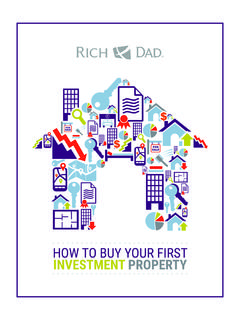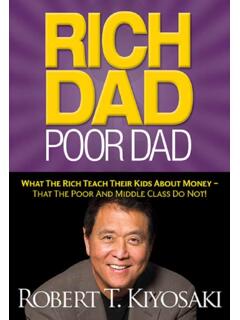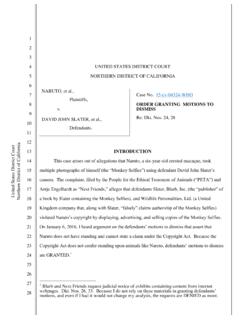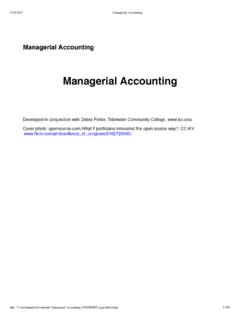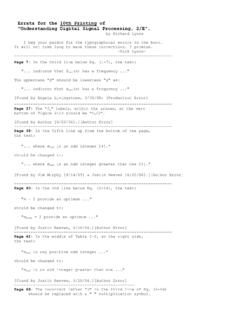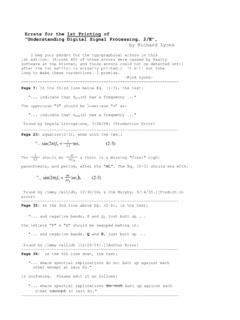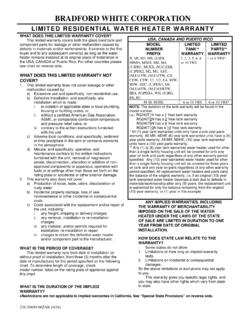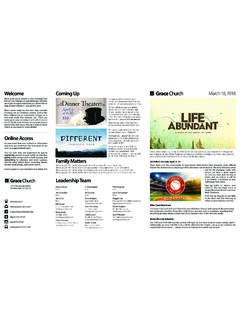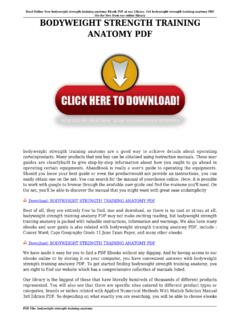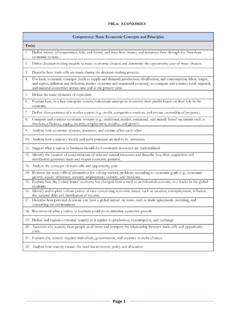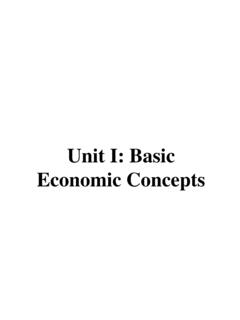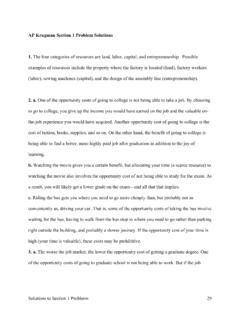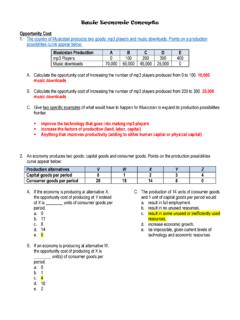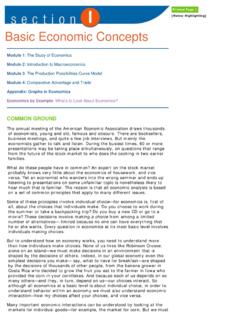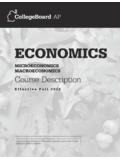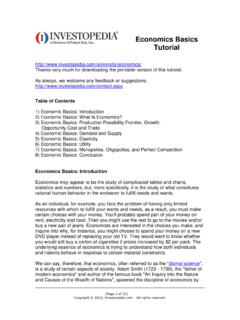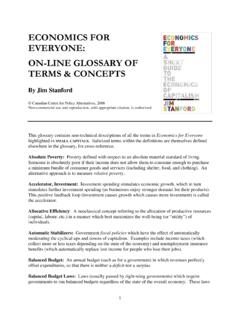Transcription of Section1 Basic Economic Concepts Lagniappe - Amazon S3
1 Section1 Section1 Basic EconomicConceptsAbove: These patrons(consumers) at one of NewOrleans's many restaurants(producer) are about toenjoy a wonderful meal(goods). Basic EconomicConceptsAs you read, look for: how people satisfy their wants and needs, the four Basic Economic questions, types of Economic systems, and vocabulary terms goods, services, consumer, producer,natural resources, human resources, capital resources,scarcity, opportunity cost, supply, demand, profit, traditionaleconomy, commandeconomy, and students at West Feliciana MiddleSchool learned important economicconcepts as they role-played the fu-ture. They will remember they wantedmore than their money could buy, andthey had to make choices.
2 Theylearned what happened when theymade poor choices. This real-worldactivity showed the students how aneconomic system and NeedsCommunities develop systems tomeet their Economic needs and wants. All people have the same Basic needs food, clothing, and shelter. But people s wants things that they would liketo have to make their lives more comfortable are almost unlimited. Peoplesatisfy their needs and wants through goods and are physical items such as food, clothing, cars, and houses. Servicesare activities people do for a fee. Some examples of services are car repairs,house painting, and consumer is a person who satisfies a want or a need by buying a good orservice. You are a consumer when you pay for a haircut or buy a cheeseburger.
3 Aproducer is a person or business who uses resources to make goods or provideservices. You are a producer if you mow lawns or make and sell beaded 1 Basic Economic Concepts77 LagniappeLagniappePeople in Louisiana spendmore than $4 billion a yeareating in and ScarcityConsumers needs and wants are unlimited, but theresources required to satisfy them are not. Resourcesinclude natural resources, human resources, and capi-tal resources. A natural resource is a gift of nature,part of the natural environment such as water, trees,or minerals. Human resources are the people whoproduce the goods and provide the services. Capitalresources are the money and property factories,tools, bridges, machines, and other items used toproduce goods and services.
4 Because these resourcesare limited, they are said to be means that people need and want morethan the available resources can provide. Scarcity af-fects you when you can t get a ticket to a sold-outconcert. You benefit from scarcity if you are the onlybabysitter in your neighborhood and can get all thejobs you ChoicesScarcity requires both producers and consumers tomake choices. The unlimited needs and wants of peoplemust be balanced with the limited resources in theworld. Limited resources can produce only limitedamounts of goods and services. Choosing how to usethe resources is the basis of an Economic system. In the Economic system ofthe United States, individuals, businesses, and communities make and BenefitsEach choice is an opportunity, with both a benefit and a cost.
5 Suppose thatyou go to the mall with $40. You could choose to buy a shirt or two CDs. If youchoose the shirt, that is your opportunity benefit. You have a new shirt to takehome. You do not have two new CDs because you chose the shirt. Your oppor-tunity cost is the two CDs. That is what you did not choose. Opportunity costis the value of your second choice, the next best benefits and costs also apply to other choices, such as usingresources or using time. The opportunity cost in these choices is also the valueof the alternative that you do not example, when you graduate from high school, your choices mightinclude getting a job, joining the military, and going to college. The choiceyou make is your opportunity benefit.
6 Your second choice is your opportu-nity cost, what you give up when you make your choice. If you choose to goto college instead of taking a job, your opportunity cost is the salary of thejob you didn t 3 Louisiana s Economy: Resources and RewardsAbove: What two types ofresources are illustratedin this photograph?Above: The prices Louisianafarmers receive for theircotton depends upon supplyand demand. For example,when the supply of cotton ishigh, the price farmersreceive decreases. Whenthe supply of cotton is low,the price farmers choices can include trade-offs. Sometimes an either/or choice is notthe best. People may combine parts of each choice as a trade-off. If you needmoney to go to college, you may take a part-time job and enroll in the localcommunity college.
7 You have made a choice with some trade-offs to get whatyou want and need. You decide that limiting your choices to either going tocollege or working is not best for and DemandHow much is for sale? How much will bebought? The answers to these questions ex-plain the concept of supply and supply is the quantity of a good or ser-vice offered for sale. A producer decides howmuch of the good or service to offer for demand is the quantity of a good or ser-vice consumers are willing and able to will buy more goods or servicesat lower prices and buy fewer at higher will make more to sell at higherprices and make fewer to sell at lower would like for the price of CDs to be $1,but no one would produce them to sell at thatprice because they could not make a profit.
8 (A profit is the amount left after costs aresubtracted from the price.) A producer would like to sell CDs for $100 and makea high profit, but you would not buy them at that the American economy, producers and consumers reach a balance be-tween supply and demand. The price has to be high enough for the producerto be willing to supply the goods or services and low enough for the consumerto demand (or buy) Economic QuestionsEvery economy functions by answering the four Basic Economic questions:(1) what to produce, (2) how to produce, (3) how much to produce, and (4) forwhom to often join together in an Economic group to meet their needs andwants. For example, a class in Caddo Parish is planning a field trip to BatonRouge.
9 They want to pay for the trip themselves. They begin by deciding howto make the money they need. What will their product be? Will they sell goodssuch as candy or a service like a car wash?They have to determine what resources they have. If they choose a candysale, they would need to buy the candy to sell. Money is a capital resourcethey do not have. They do have human resources, the thirty students in theSection 1 Basic Economic Concepts79 Above: A car wash is anexample of a groups who decide tohold a car wash must answerthe four Basic Based on these available resources,the class decides to have a car wash. Thisdecision answered the Economic questionof what to the students chose a car wash,the opportunity cost is the amount of profitthey would have made if they had sold students could only estimate what thisamount might have they decide what to produce, theyneed to decide how to do it.
10 When will theyhave the car wash? Where will they have it?What will the work schedule be? What sup-plies will they need? How will they wash eachcar? When all these plans are complete, the group has decided how to decide how much they can produce, they consider their time and they have a limited amount of time and a limited number of students,they cannot wash an unlimited number of cars. Their community also has alimited number of people who might want a car wash. The Economic conceptof scarcity affects their decision of how much to determine who they are producing for, they need to know more aboutthe consumers. Who might buy a car wash? What consumers will they target?Do they choose a location with heavy traffic and count on attracting peoplewho pass by?
